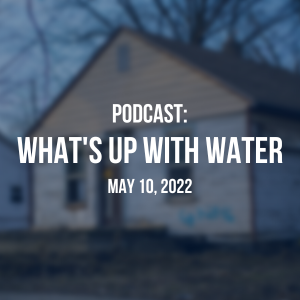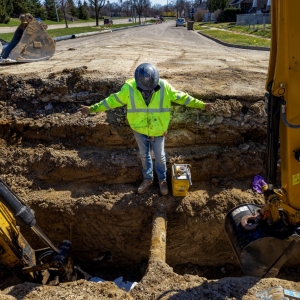 https://www.circleofblue.org/wp-content/uploads/2022/04/2022-04-14-Michigan-Waters-True-Cost-JGanter-1502-Edit-2500.jpg
912
1600
Brett Walton
https://www.circleofblue.org/wp-content/uploads/2018/06/Circle-of-Blue-Water-Speaks-600x139.png
Brett Walton2022-05-02 07:18:482022-12-09 10:52:35After Decades of Neglect, Bill Coming Due for Michigan’s Water Infrastructure
https://www.circleofblue.org/wp-content/uploads/2022/04/2022-04-14-Michigan-Waters-True-Cost-JGanter-1502-Edit-2500.jpg
912
1600
Brett Walton
https://www.circleofblue.org/wp-content/uploads/2018/06/Circle-of-Blue-Water-Speaks-600x139.png
Brett Walton2022-05-02 07:18:482022-12-09 10:52:35After Decades of Neglect, Bill Coming Due for Michigan’s Water InfrastructureShort-Changing Michigan Local Governments Has Resulted in Deteriorating Water Systems and Other Services
Many of Michigan’s 1,773 cities, villages, and townships are reaching a water infrastructure crisis point.

Throughout the Great Lakes region and across the U.S., water systems are aging. In some communities, this means water bills that residents can’t afford or water that’s unsafe to drink. It means that vulnerable systems are even more at risk in a changing climate. From shrinking cities and small towns to the comparatively thriving suburbs, the true cost of water has been deferred for decades.
As the nation prepares to pour hundreds of billions of federal dollars into rescuing water systems, the Great Lakes News Collaborative investigates the true cost of water in Michigan.
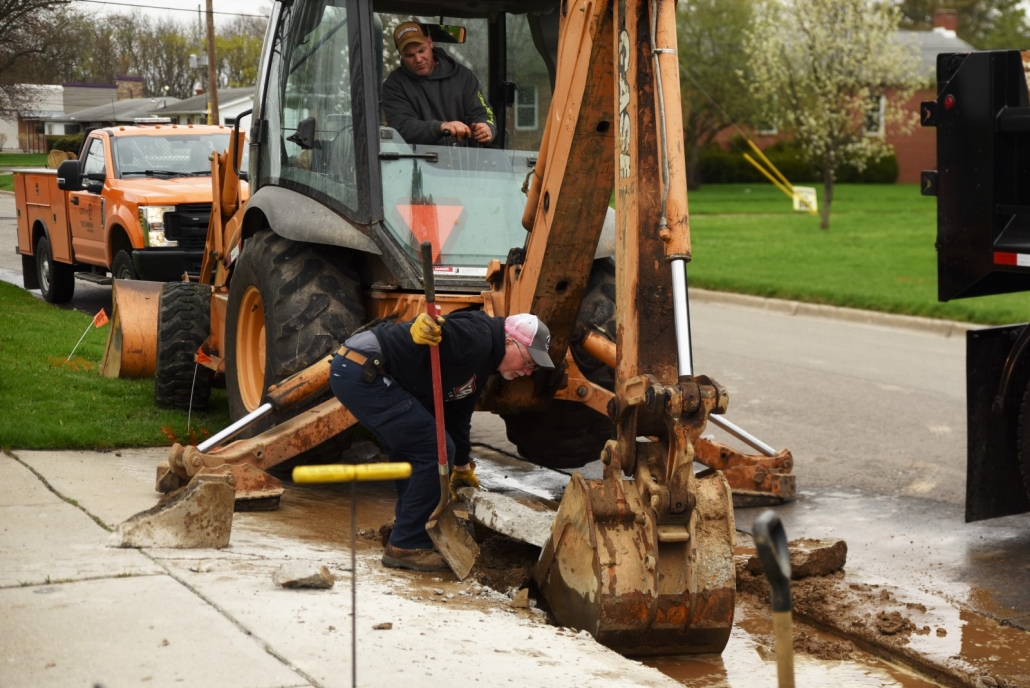
A City of Tecumseh crew excavates part of a concrete driveway to get to a broken water main. Getting enough money from the state and federal governments to help maintain city services has become a struggle for many Michigan municipalities. Lester Graham / Michigan Radio
This is part six of a ten-part series.
By Lester Graham, Michigan Radio – May 9, 2022
Michigan has had its share of disasters. Dams collapsed after heavy rains, flooding Midland. A sinkhole the size of a football field was caused by a sewer collapse in Macomb County. And in Flint, children were exposed to lead-contaminated water.
“Flint was a financial crisis long before it was a water crisis, and those two things are intricately connected,” said Stephanie Leiser, a lecturer with the Ford School of Public Policy at the University of Michigan. She says cities and towns across Michigan face increasingly desperate choices as they struggle to maintain their infrastructure – many of them with a shrinking number of taxpayers to foot the bill.
Many of Michigan’s 1,773 cities, villages, and townships are reaching a crisis point because of a decline in federal dollars for water and sewer infrastructure that’s made worse by the state’s centralized taxing system.
Small disasters can be devastating, too. Many of Michigan’s rural communities have to haul water in trucks to fight fires. That’s because they cannot put too much of a strain on the water system by tapping the fire hydrants.
That’s the case in the small village of Akron, in Tuscola County.
“I know if we start using too much water, we end up not having to use the hydrants because we can’t let the pressure get too low and make everybody boil water, so we’ll stop using the hydrants,” Marvin Hasso Jr. of the village’s Department of Public Works, a one-man operation, explained.
As we explained earlier in this series, Akron’s water tower has reached its life expectancy and doesn’t have the capacity to hold the amount of water that’s recommended by the state. Hauling water is the only alternative.
“There has been significant disinvestment in our communities over the course of the last couple of decades. And you couple that with a restrictive property tax system and it absolutely squeezes local government at its core, which is to provide service,” said John LaMacchia, director of State and Federal Affairs for the Michigan Municipal League.
He is one of many people who work closely with Michigan’s cities and villages who are pleading with state government to stop short-changing the municipalities responsible for providing critical services such as safety and water.
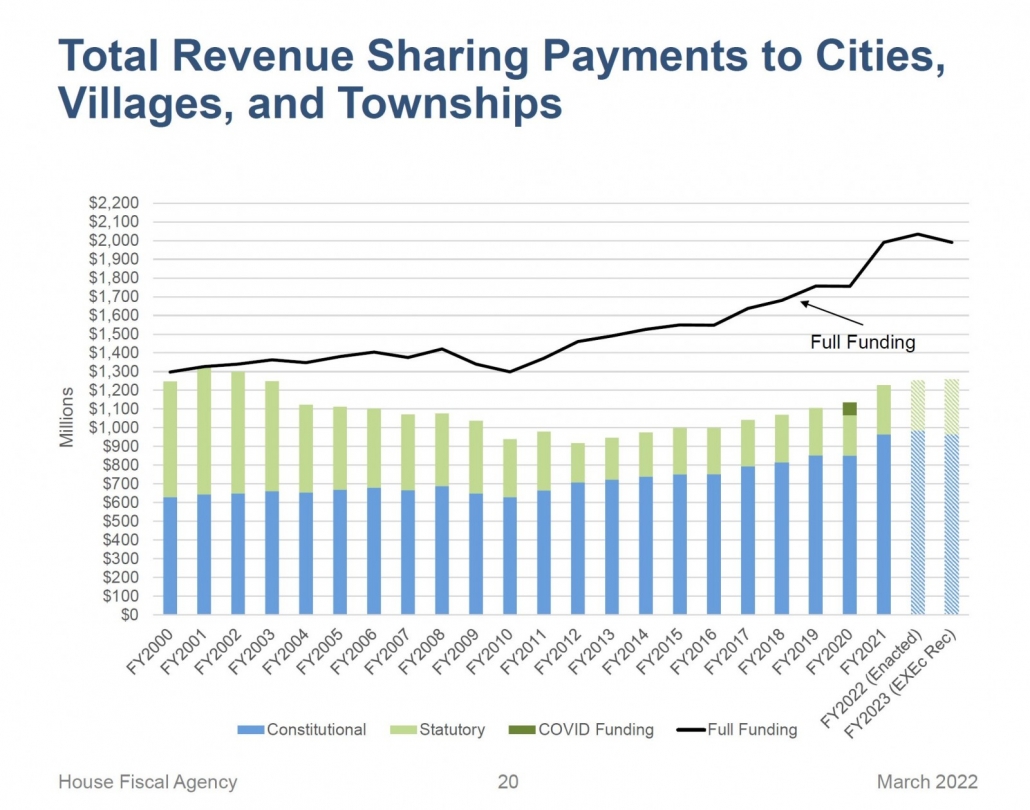
Revenue Sharing graph. Michigan House Fiscal Agency.
We used to build in America
Much of the water and sewer infrastructure in Michigan began with a huge move by the federal government to fund the building of water and sewer systems starting in the late 19th century. The federal government passed the Clean Water Act in 1972, and spending on drinking water and wastewater systems skyrocketed. By the late 1970s the federal government was spending more than $20 billion (in 2022 dollars) a year on water and wastewater utility infrastructure.
That federal investment fell dramatically after 1980 and continued to decline to as little as $2 billion in 2008. The American Recovery and Reinvestment Act of 2009 caused a spike in spending on water infrastructure, but it quickly fell back to about $3 billion a year.
“There’s been a drastic shift in the amount of money that the federal government used to put into these systems compared to what they do now,” said LaMacchia with the Municipal League.
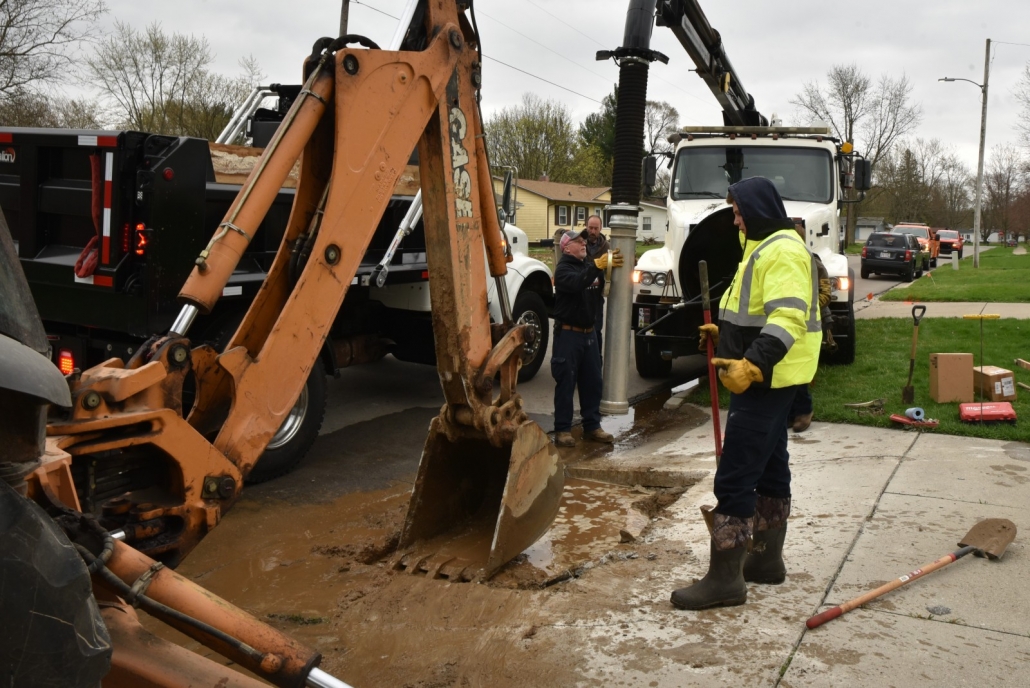
A work crew gets ready pump out water as it digs down to repair a broken water main. Lester Graham / Michigan Radio
Not sharing as fairly
The State of Michigan has also been indirectly reducing the money that municipalities can spend on water and wastewater infrastructure through a series of changes in how Michigan distributes taxes.
The Headlee Amendment to the Michigan Constitution 1978 put complicated limits on state and local taxes. Then Proposal A, passed by voters in 1994, put further restrictions on how property taxes could increase. With rising property values and tax hikes, that seemed like a great idea at the time. But with the Great Recession, property values dropped significantly. They’ve recovered and then some, but the taxes they generate cannot catch up at the same pace because of Proposal A limits.
The other tax change also came because of the Great Recession. Sales taxes are sent to the state and a portion is redistributed to cities, villages, and townships. Part of it is mandated by the Constitution. A second formula, called the statutory share, ended when the state budget got tight. Now, instead of sharing that portion of the sales tax, the legislature simply distributes what it wants each year.
“And that really is funded about $600 million short of where it should be every year, and that’s compounded the billions and billions and billions of dollars over the last decade plus,” LaMacchia noted.
Actually, that shortfall has increased to $800 million this past year because the state has been getting a lot more money, but not sharing much of it.
LaMacchia said now municipalities also have to factor in the significant rise in inflation, currently above eight percent.
“You really have this almost perfect storm of things that are taking what is already a limited supply of revenue sources and then adding these additional burdens and cost increases to them.”

Stephanie Leiser is a lecturer at the University of Michigan. She works with a regular survey of municipal leaders through the Center for Local, State, and Urban Policy. Lester Graham / Michigan Radio
Higher local taxes and fees
As cities are relying more on residents.
“The problem is that they have to turn to more regressive forms of property taxes, fines, fees and other charges, which really disproportionately harms families with low incomes and our black and brown communities,” said Rachel Richards, Fiscal Policy Director with the Michigan League for Public Policy.
Families are still paying the same rate of sales tax that goes to state government, but their communities are getting less of it back. That’s led to municipalities relying more on millages. Citizens pay more in property taxes, which also leads to higher rent. Local governments are implementing more fees or increasing fees for utilities such as water and sewer. It’s all an attempt by local government to keep something close to the same level of service.
Richards said the legislature could give cities more money from its general fund to invest in water infrastructure. The idea is that the money would keep water rates affordable for families and avoid crisis-level situations when it comes to water and wastewater service.
Part of the water infrastructure crisis is the lack of political will to pay for it. If an elected official votes to spend money to improve a park or make living in a town obviously nicer, that earns voters’ respect. Voting to spend money on pipes under the ground when there’s not an obvious problem is less likely to win votes. But, waiting until there’s an obvious problem often results in a crisis either for a neighborhood or sometimes an entire city.
Get a loan (if you can)
In lieu of direct assistance, state government points to the revolving loan funds available for both drinking water and wastewater systems. Larger cities are often staffed with engineers and people who know how to complete the complex applications. But for smaller cities and villages, that’s just not reality.
“We talked to several communities that said it’s just a really difficult application process….. So just filling out the forms and the paperwork to actually get in the door and see if you can get this help is prohibitive for many communities,” said Stephanie Leiser who works with a regular survey of municipal leaders through the Center for Local, State, and Urban Policy.
Small towns would have to spend a lot of money to hire consultants to see if they even qualified for a loan from the revolving fund. The Michigan Department of Environment, Great Lakes, and Energy (EGLE) said it will help small towns determine whether it’s worth the effort.
The other problems are, even though some loans are forgivable through the federally funded program, if it’s not, those small towns might not be able to afford the debt. Even if they determine they can afford the loan, the rates on the revolving loan fund are sometimes higher than the municipal bond market rate for some towns. That’s something EGLE said it’s working to improve.
John LaMacchia confirms that just the application process is a major hurdle for many municipalities.
“You know, when we think about communities and their ability to apply for things like grant funding or loans that are out there, you know, sometimes they look at it and say, I don’t understand the process,” LaMacchia said. “And if they don’t understand the process, it makes it much harder for them to get into the process.”
The Michigan Municipal League Foundation launched a program to give those small towns access to experts for free through grants from the Joyce Foundation and the C.S. Mott Foundation. That’s expected to help
The really bright light in Michigan’s infrastructure needs is a pile of federal money coming.
“With the American Rescue Plan and resources that our local units are getting with the new Infrastructure Investment and Jobs Act puts more resources into the fold,” said LaMacchia.
But that assistance is a one-time fix. And with deteriorating water infrastructure in cities large and small, it will take decades of new investment to recover.
“The backlog is so big, the deferred maintenance is so large that I doubt it’s going to make a huge difference,” Stephanie Leiser said, adding, “If you are not maintaining your infrastructure assets, you are at higher risk of disasters.”
CLARIFICATION: An earlier version of this story stated that children in Flint had been poisoned by lead-tainted water. No level of lead in the blood is considered safe, and lead is a poison. The CDC defines acute “lead poisoning” as a blood level > 45µg/dL. During the Flint water crisis, children in Flint had elevated lead levels in their blood and that does create harmful, lasting effects. The state health department defines elevated blood lead levels as > 3.5 µg/dL. After Flint switched water sources, the rate of elevated blood lead levels in Flint’s children doubled.
Read the full series
 https://www.circleofblue.org/wp-content/uploads/2022/04/2022-04-14-Michigan-Waters-True-Cost-JGanter-1502-Edit-2500.jpg
912
1600
Brett Walton
https://www.circleofblue.org/wp-content/uploads/2018/06/Circle-of-Blue-Water-Speaks-600x139.png
Brett Walton2022-05-02 07:18:482022-12-09 10:52:35After Decades of Neglect, Bill Coming Due for Michigan’s Water Infrastructure
https://www.circleofblue.org/wp-content/uploads/2022/04/2022-04-14-Michigan-Waters-True-Cost-JGanter-1502-Edit-2500.jpg
912
1600
Brett Walton
https://www.circleofblue.org/wp-content/uploads/2018/06/Circle-of-Blue-Water-Speaks-600x139.png
Brett Walton2022-05-02 07:18:482022-12-09 10:52:35After Decades of Neglect, Bill Coming Due for Michigan’s Water Infrastructure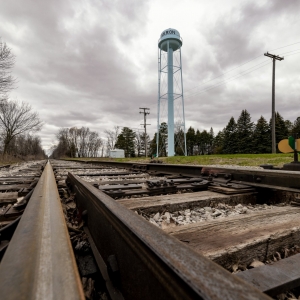
Many Rural Towns Have Neglected Drinking Water Systems for Decades
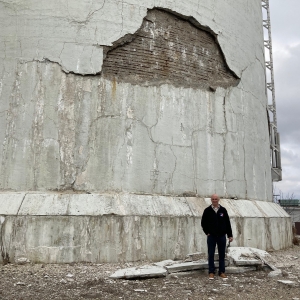
Water Woes Loom for Michigan Suburbs, Towns After Decades of Disinvestment
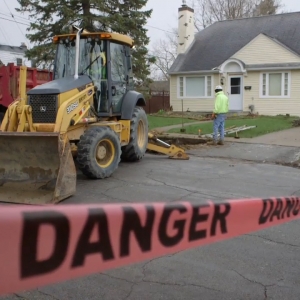
Michigan’s 20th Century Water Systems Too Big For Its Shrinking City Populations
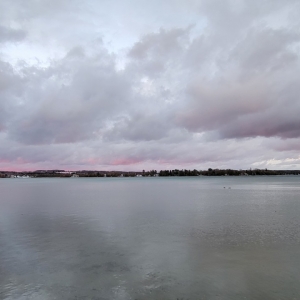
Michigan’s Lack of Septic System Regulations is Causing Problems for Some of its Most Pristine Lakes
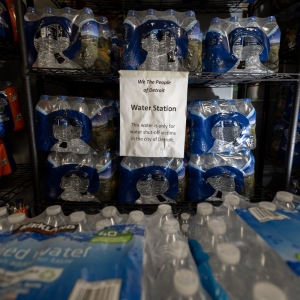
High Cost of Water Hits Home
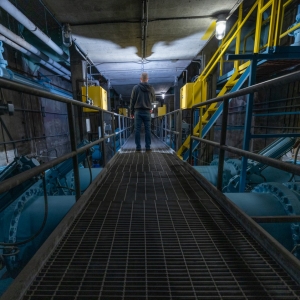
Some Michigan Water Systems Are Overbuilt, Underfunded. Are Mergers The Answer?
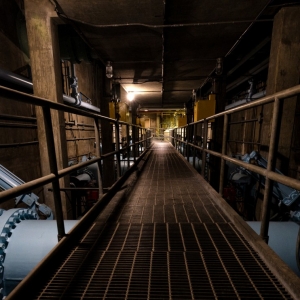
Michigan’s ‘Very Big Opportunity’ in Infrastructure Windfall
Water’s True Cost
The Great Lakes News Collaborative includes Bridge Michigan; Circle of Blue; Great Lakes Now at Detroit Public Television; and Michigan Radio, Michigan’s NPR News Leader; who work together to bring audiences news and information about the impact of climate change, pollution, and aging infrastructure on the Great Lakes and drinking water. This independent journalism is supported by the Charles Stewart Mott Foundation. Find all the work here.
Related
© 2023 Circle of Blue – all rights reserved
Terms of Service | Privacy Policy



